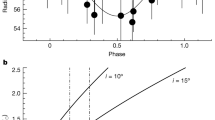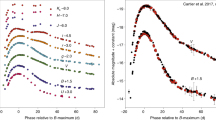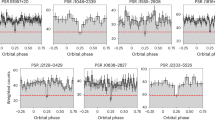Abstract
Two types of supernova are thought to produce the overwhelming majority of neutron stars in the Universe1. The first type, iron-core-collapse supernovae, occurs when a high-mass star develops a degenerate iron core that exceeds the Chandrasekhar limit2. The second type, electron-capture supernovae, is associated with the collapse of a lower-mass oxygen–neon–magnesium core as it loses pressure support owing to the sudden capture of electrons by neon and/or magnesium nuclei3,4. It has hitherto been impossible to identify the two distinct families of neutron stars produced in these formation channels. Here we report that a large, well-known class of neutron-star-hosting X-ray pulsars is actually composed of two distinct subpopulations with different characteristic spin periods, orbital periods and orbital eccentricities. This class, the Be/X-ray binaries, contains neutron stars that accrete material from a more massive companion star5. The two subpopulations are most probably associated with the two distinct types of neutron-star-forming supernova, with electron-capture supernovae preferentially producing systems with short spin periods, short orbital periods and low eccentricities. Intriguingly, the split between the two subpopulations is clearest in the distribution of the logarithm of spin period, a result that had not been predicted and which still remains to be explained.
This is a preview of subscription content, access via your institution
Access options
Subscribe to this journal
Receive 51 print issues and online access
$199.00 per year
only $3.90 per issue
Buy this article
- Purchase on Springer Link
- Instant access to full article PDF
Prices may be subject to local taxes which are calculated during checkout



Similar content being viewed by others
References
Heger, A., Fryer, C. L., Woosley, S. E., Langer, N. & Hartmann, D. H. How massive single stars end their life. Astrophys. J. 591, 288–300 (2003)
Woosley, S. & Janka, T. The physics of core-collapse supernovae. Nature Phys. 1, 147–154 (2005)
Nomoto, K. Evolution of 8–10 solar mass stars toward electron capture supernovae. I - Formation of electron-degenerate O + NE + MG cores. Astrophys. J. 277, 791–805 (1984)
Nomoto, K. Evolution of 8–10 solar mass stars toward electron capture supernovae. II - Collapse of an O + NE + MG core. Astrophys. J. 322, 206–214 (1987)
Reig, P. Be/X-ray binaries. Astrophys. Space Sci. 332, 1–29 (2011)
Lee, U., Osaki, Y. & Saio, H. Viscous excretion discs around Be stars. Mon. Not. R. Astron. Soc. 250, 432–437 (1991)
Harris, J. & Zaritsky, D. The star formation history of the Small Magellanic Cloud. Astron. J. 127, 1531–1544 (2004)
Haberl, F. & Pietsch, W. X-ray observations of Be/X-ray binaries in the SMC. Astron. Astrophys. 414, 667–676 (2004)
Coe, M. J., Edge, W. R. T., Galache, J. L. & McBride, V. A. Optical properties of Small Magellanic Cloud X-ray binaries. Mon. Not. R. Astron. Soc. 356, 502–514 (2005)
Waters, L. B. F. M. & van Kerkwijk, M. H. The relation between orbital and spin periods in massive X-ray binaries. Astron. Astrophys. 223, 196–206 (1989)
Li, X. & van den Heuvel, E. P. J. On the relation between spin and orbital periods in Be/X-ray binaries. Astron. Astrophys. 314, L13–L16 (1996)
Liu, Q. Z., Li, X. D. & Wei, D. M. in High Energy Processes and Phenomena in Astrophysics (eds Li, X. D., Trimble, V. & Wang, Z. R. ) 215–217 (Proc. IAU Symp. 214, Univ. Chicago Press, 2003)
Corbet, R. H. D. Be/neutron star binaries: a relationship between orbital period and neutron star spin period. Astron. Astrophys. 141, 91–93 (1984)
de Jager, C., Nieuwenhuijzen, H. & van der Hucht, K. A. Mass loss rates in the Hertzsprung-Russell diagram. Astron. Astrophys. Suppl. Ser. 72, 259–289 (1988)
Tout, C. A. & Hall, D. S. Wind driven mass transfer in interacting binary systems. Mon. Not. R. Astron. Soc. 253, 9–18 (1991)
Podsiadlowski, P. et al. The double pulsar J0737–3039: testing the neutron star equation of state. Mon. Not. R. Astron. Soc. 361, 1243–1249 (2005)
Podsiadlowski, P. et al. The effects of binary evolution on the dynamics of core collapse and neutron star kicks. Astrophys. J. 612, 1044–1051 (2004)
Poelarends, A. J. T., Herwig, F., Langer, N. & Heger, A. The supernova channel of super-AGB stars. Astrophys. J. 675, 614–625 (2008)
van den Heuvel, E. P. J. in ESA SP-552: Proc. 5th INTEGRAL Workshop “The INTEGRAL Universe” (eds Schoenfelder, V., Lichti, G., & Winkler, C. ) 185–194 (ESA Spec. Publ. 552, European Space Agency, 2004)
Schwab, J., Podsiadlowski, P. & Rappaport, S. Further evidence for the bimodal distribution of neutron-star masses. Astrophys. J. 719, 722–727 (2010)
Coe, M. J. An estimate of the supernova kick velocities for high-mass X-ray binaries in the Small Magellanic Cloud. Mon. Not. R. Astron. Soc. 358, 1379–1382 (2005)
Antoniou, V., Zezas, A., Hatzidimitriou, D. & Kalogera, V. Star formation history and X-ray binary populations: the case of the Small Magellanic Cloud. Astrophys. J. 716, L140–L145 (2010)
Coe, M. J., McBride, V. A. & Corbet, R. H. D. Exploring accretion theory with X-ray binaries in the Small Magellanic Cloud. Mon. Not. R. Astron. Soc. 401, 252–256 (2010)
Linden, T., Sepinsky, J. F., Kalogera, V. & Belczynski, K. Probing electron-capture supernovae: X-Ray binaries in starbursts. Astrophys. J. 699, 1573–1577 (2009)
Ashman, K. M., Bird, C. M. & Zepf, S. E. Detecting bimodality in astronomical datasets. Astron. J. 108, 2348–2361 (1994)
Acknowledgements
Research support for this project was provided by the UK Science and Technology Facilities Council. We would like to thank T. Maccarone and T. Linden for discussions.
Author information
Authors and Affiliations
Contributions
C.K. carried out the statistical analysis for this project and wrote most of the text. M.J.C. compiled the high-mass X-ray binary data set that forms the basis for our analysis, and collaborated with C.K. on all aspects of the project from its inception. P.P. contributed to the theoretical interpretation of the results and to the final text. All authors discussed the results and their presentation.
Corresponding author
Ethics declarations
Competing interests
The authors declare no competing financial interests.
Supplementary information
Supplementary Information
This file contains Supplementary Text 1-4, Supplementary Figure 1 with a legend and additional references. (PDF 289 kb)
Rights and permissions
About this article
Cite this article
Knigge, C., Coe, M. & Podsiadlowski, P. Two populations of X-ray pulsars produced by two types of supernova. Nature 479, 372–375 (2011). https://doi.org/10.1038/nature10529
Received:
Accepted:
Published:
Issue Date:
DOI: https://doi.org/10.1038/nature10529
Comments
By submitting a comment you agree to abide by our Terms and Community Guidelines. If you find something abusive or that does not comply with our terms or guidelines please flag it as inappropriate.



